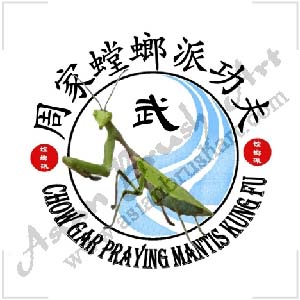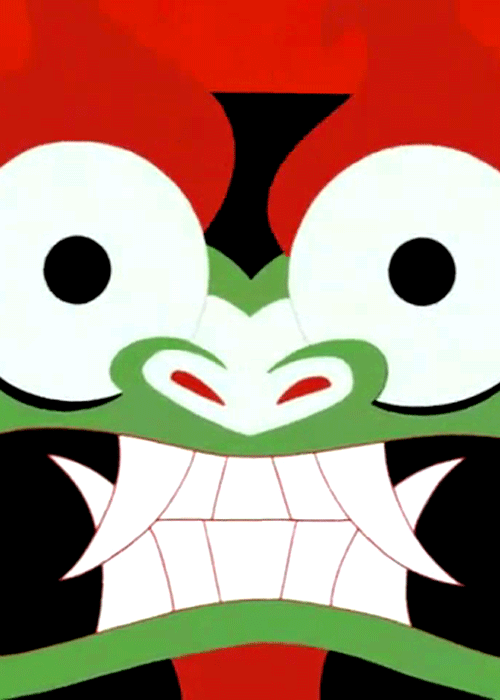Chow Gar Praying Mantis Kung Fu  History
History:
The Chow's Family Praying Mantis Kung Fu system started about 250 years ago. Its founder was a monk called Chow Ah Naam. Chow Ah Naam was a resident at the Shaolin Monastery (Sil Lum Jee) from the age of 10 years old, he went there initially to be cured for a stomach ailment. He stayed there and started training to be a cook and in his spare time learned the martial arts of the temple. It was noted that he had a natural aptitude for fighting and as such he progressed through the systems of the temple with great speed.
During Chow Ah Naam's stay at the temple he had a work mate named Set. Set was a big powerful man, and he thought himself the strongest of the lot. He had been training Kung Fu for many years and was always picking on others, so Chow Ah Naam tried to avoid him.
One day Set was carrying two buckets of water and Chow Ah Naam accidentally bumped into him. Set was angry and hit Chow Ah Naam. Although Chow Ah Naam tried to defend himself he was knocked down with one punch.
Some time later Chow Ah Naam was in a nearby forest collecting wood for the stove in the kitchen. He heard a commotion and looked up to see a bird using its beak against a Praying Mantis. Watching closely he saw the Mantis suddenly cut across the birds throat with it's arm; the bird fell and was covered in blood - it had stopped moving.
Chow Ah Naam was very surprised at this incident and being an intelligent person it occurred to him to copy this insect. He caught the Praying Mantis and many others after it, feeding them and using a twig to test their fighting reaction. Gradually he developed his boxing style based on the principles of these insects.
Nobody knew about this in the Shaolin Temple until one day, a few years later Set was showing off in front of some monks as Chow Ah Naam was passing through. The big man decided to pick on him, and Chow Ah Laam realized he could not avoid the challenge.
Set struck out at Chow Ah Naam, who was cool and avoided all his punches. Set became angry and used all his power to try to knock him down. All the other monks around were shouting and jeering, the noise was loud and so disturbed the Head Monk Sim Yan.
Sim Yan went to investigate what was going on and saw Chow Ah Naam fighting. Sim Yan knew that his fighting style was different to the Shaolin style, and while he was watching, Chow Ah Naam struck out at Set knocking him down to the ground.
Sim Yan stopped the contest and asked where Chow Ah Naam studied his Kung Fu. Chow Ah Naam told the head Monk that he had observed the Praying Mantis' fighting habits and developed a system based on this.
Sim Yan praised Chow Ah Naam's ingenuity because there were not many people like him. Sim Yan personally taught Chow Ah Naam the highest of the Shaolin Temple training to develop a strong and powerful bridge. These techniques harnessed the body's hidden powers to make the body almost totally resistant to blows, except to pressure point strikes.
After years of training Chow Ah Naam was able to partially close the "holes" and cover some of the pressure points with well developed tendons, and as a result of of this, he also found that he had developed great strength and could easily overpower the other taught styles with the famous bridge arm. With this excellent achievement Chow Ah Naam was given the Hall of Shoalin where it was recognised that he should teach this elite art.
Of all the monks Chow Ah Naam taught this system to, it was Wong Fook Go who became his best student, and later his successor. Wong Fook Go was a traveling monk, which was quite common at this time. After years of traveling around China he stopped at a place called Wai Yearn village in the area of Tung Kung. This is where he met a young man called Lau Soei.
Lau Soei was an accomplished Master of several arts most notably the Ma Kuen or Horse Fist system. On the day of their meeting, Lau Soei was giving a demonstration. When he saw that Wong Fook Go did not look impressed, he challenged him (challenges at that time were seen as opportunities to test your skills against those of your opponent).
Inevitably, Lau Soei lost the bout, but was intrigued by the Gen (shock) power that the monk had used. Nevertheless, he challenged Wong Fook Go once more. Again he was beaten. Wong Fook Go must have seen the strength of character of Lau Soei and decided to teach him, and ended staying in the village for several years, and teaching Lau Soei the whole system. Lau Soei moved to Hong Kong in 1913 and began teaching Chow Gar Kung Fu to the local population. This included Grandmaster Ip Shui, Chu Gung Wa among others.
Ip Shui went on to become Lau Soei's successor and defeated anyone that challenged his position as Head of the Chow's Family Praying Mantis Kung Fu system. He defeated many famous fighters in bare hand challenges, no one was successful.
Grandmaster Ip Shui was not only famous for his countless undefeated fights. He ran a small Dit Dar clinic in Kowloon city where he treated people with all types of ailments, with Dit Dar herbal medicine, and Wafu (Wafu is a special skill, using only mantra prayers and a brush and water. He was one of the last to practice this unique and special skill) until he passed away on 27 April 2004.
Grandmaster Ip Chee Keung became the new Grandmaster when his father (Ip Shui) handed on the System to him at his 90th birthday celebrations in December 2002.
Doc



















